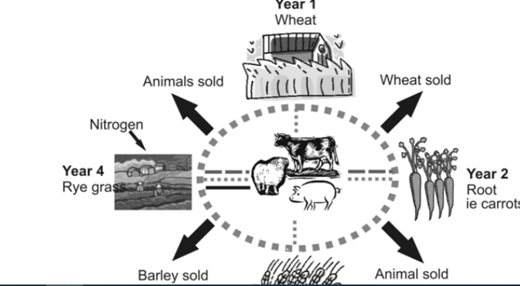Click here to view a video that explains crop rotation diversification.
Farmers have long known the value of crop rotation for keeping their soils productive and crops healthy.
Crop rotation includes growing crops from different plant families; leguminous and non-leguminous plants in successive growing seasons. This helps to reduce the build-up of soil pests and diseases that might accumulate between seasons when growing the same crop.
Here you do not plant the same crop in the same place year after year, but you make sure that a different crop is planted in each space. This is a good idea because:
- It prevents or stops the accumulation of insects and diseases. If the same crop is planted, some insects and diseases will become more every year!
- Different crops use different nutrients or plant food stored in the soil. In this way, you do not overuse some of the plant food while not using others.
- The soil can be covered all year round.
- Some crops add nutrients or nitrogen to the soil. Examples are beans, peas, broad beans, soya beans, peanuts, cowpeas, lucerne and clover.
- It prevents the soil from building up bad or negative reactions to specific plants. An example here is nematodes on tomatoes and swiss chard. Nematodes are very small worms, that we cannot see with our eyes. They live in the soil and feed on the roots of your plants.
- There is no build-up of specific weeds.
In the first season after applying compost and or manure, heavy feeders or nitrogen consumers are planted. In the second season, the light feeders are planted, and in the third season, legumes are planted. This is followed by another application of compost or manure and the cycle is repeated.
In trench beds, where the organic matter is decaying slowly in the soil, you may want to start with legumes, move on to heavy feeders or nitrogen consumers and then move on to light feeders. This is because during the decaying process plant nutrients will take a while to become available for use by plants. The legumes can fix most of their own nitrogen and are thus a better starting point.
Prepare the land or bed well. Put a lot of compost or manure in your bed (four full spades/m²). Then, start by planting a fruiting crop. Leaf crops are needless and can follow fruit crops. Then, root crops can follow leaf crops without much addition of plant food. Root crops like fertile soil, but do not like fresh manure or compost. It must be well-rotted. Then nitrogen fixers can follow, with the addition of little or no plant food. Then you need to prepare the land well again. Start once more with fruiting crops.
Preparing the Land or Bed
This would mean trenching or double digging or the addition of a lot of compost/manure forked into the top 30cm. You will need at least four full spades/m².
A general recommendation is to place 30 tons of compost or manure on a hectare of land. This comes to about one half of a wheelbarrow load for every square metre. This is about the same as four full spades!
Advantages and Disadvantages of Crop Rotation

Click here to view an information sheet about what crop rotation is.
Click here to view an information sheet about crop rotation.
Norfolk Four-Course Rotation

The picture below illustrates the Norfolk four-course rotation system, which allows sustainability that increases productivity from these farmlands.
